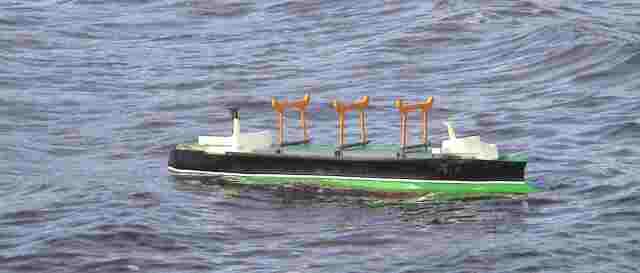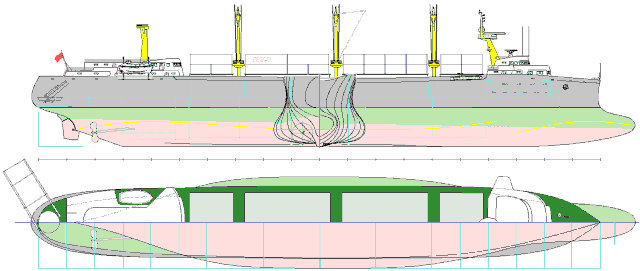
- •Часть 1 настоящего издания shipbuilding, автор Чумаков м. А. Удк 802.0:629.12(075.8) ббк 81.2Англ.Я 7. Вышла в свет в 2007 году в бнту
- •Unit I water vessels
- •Text 1a
- •Text 1b
- •Text 1c
- •Unit II passenger ships
- •Text 2a
- •Text 2b
- •Text 2c
- •Unit III cargo ships
- •Text 3a
- •Text 3b
- •Text 3c
- •Unit IV
- •Specialized vessels
- •Text 4a
- •Text 4b
- •Text 4c
- •Unit V art of shipbuilding
- •Text 5a
- •Text 5b
- •Text 5c
- •Unit VI shipbuilding technologies
- •Text 6a
- •Text 6b
- •1. Deck; 2. Transverse bulkhead; 3. Side frame; 4. Stem; 5. Forepeak; 6. Side stringer; 7. Double bottom; 8. Floor; 9. Afterpeak; 10. Sternpost; 11. Hatch; 12. Carling; 13. Deck beam
- •Synonyms:
- •Antonyms:
- •Text 6c
- •Installations
- •Hull Installation Work:
- •Electrical Installation:
- •3) Installation of the Auxiliary Machinery:
- •4) Installation of Boilers:
- •Unit VII shipbuilding in belarus
- •Text 7a
- •Text 7b
- •Text 7c
- •Belarusian sea port
- •Unit VIII future perspectives of ship-building
- •Text 8a
- •Ships of the future
- •Text 8b
- •Text 8c
- •Intelligent systems of ship automation
- •Supplementary texts
- •Vessel familiarization While Staffing a Liner
- •Minimum Requirements for the Vessel Personnel
- •Systems Of Signals
- •Navy ships of the early xxth century
- •Three from catalina
- •A “baby” in the cats’ family
- •Addison’s shipyards
- •Perspective ships. General requirements and ways of implementing
- •The main directions of the development and the features of the perspective ships
- •Appendix Types of Boat Hulls
- •Major Shipwrecks
- •Directions of a Boat
- •Abbreviations and symbols
- •Some geographical and proper names
- •Vocabulary
- •Contents
-
-
Text 8a
-
Ships of the future
-
Future ships will be even more efficient than those of today and so will cost less to operate. More and more ships will carry containerized cargo, and all ships will be larger. Ships will become increasingly automated. A staff of engineers will no longer need to stand watch in the engine room. Instead, ship engines will be operated from the bridge, just as plane engines are run from the pilot's cabin. Electronic equipment will navigate tomorrow's ships automatically. A computer will determine a ship's course and, by sending the information to machinery that regulates the rudder, steer the vessel.
As a result of these developments, ship officers will receive increased technical training. Crews will become smaller. Ship maintenance will no longer be done at sea by the crew, but in port by specialized workers. To avoid such maintenance work as painting, the bridge, cabins, and other structures on the main deck will be built of aluminum and other materials that do not rust and that resist wear from the chemicals in seawater. The officers and crew of a ship work as a team to see that the passengers, the cargo, and the ship itself arrives at their destination safely and on time.
Speaking on shipbuilding principles of the coming century, in the prospective project of a future ship the following six interdependent rules, received from the historical analysis of properties of ship architecture, should be included:
1. Displacement of the center of gravity to a bow, advancing the dynamic center of lateral resistance. It will provide stabilization of tossing at a movement on excitement and create the preconditions for safe storming;
2. Essential reduction of the area, and also cross and longitudinal moments of inertia of a waterline surface, and sharpening of stem and stern posts it in extremities. (For reduction the influence of moderate excitement and preservation of fastness in conditions of real ocean navigation);
3

4

Pic. 40. In the project of a universal vessel is shown, that the realization of the form of the hull satisfying to all set forth above requirements to seaworthiness, is possible even for the most complex universal vessel.
5. Allocation of the basic surface volumes in a stern part of the hull that takes into account properties of real storm roughness and does not prevent preservation of a course and maneuvering;
6. Essential reduction of windage height of superstructures, remembering that the beauty of the ship is defined by absence of unnecessary things on board.
Ex.7. Answer the questions:
-
Does the prospective project of a future ship require any changes of technical facilities and personel?
-
What materials can be more preferable to build the bridge, cabins and other structures on the main deck?
-
What arrangements must be done for reduction the influence of moderate excitement and preservation of fastness in conditions of real ocean navigation?
-
What can create conditions for active management of a course of a vessel?
-
What is the beauty of a ship defined by?
Ex. 8. Agree or disagree with the following statements. Give grounds to your answer:
-
Substantial minimization of the area, cross and longitudinal moments of inertia of a waterline surface, sharpening of stem and stern posts reduce the impacts of waves in extremities.
-
Essential reduction windage height of superstructures defines the beauty of a ship.
-
Exclusion of boards flares, wide and continuous top deck and inclination forward of surface part of the stem will solve a problem of excessive tossing and impacts of waves on the hull and on the deck.
-
Placing on the basic surface volumes in a stern part of the hull envisages (предусматривает) the real storm roughness and good maneuvering during storm navigation.
-
One of the several rules received from the historical analysis of properties of ship architecture is essential reduction of the hull.
Ex. 9. Translate into English:
-
Корабли будущего будут более эффективны, чем в настоящее время и намного более автоматизированы.
-
Технические работы на корабле будут производиться не командой в море, а специалистами на берегу.
-
Значительное сокращение высоты надпалубных сооружений также поможет улучшить маневрирование судна во время шторма.
-
Исключение бортовых выступов, широкой и длинной верхней палубы, как и наклон передней части носа корабля позволит решить некоторые проблемы навигации в штормовой ситуации.
-
Перенос центра тяжести на нос корабля и перемещение центра динамики горизонтального сопротивления обеспечит стабилизацию движения корабля при волнении на море.
Ex. 10. Define the main topic and idea of the text, split it into the logical parts, and make up the plan of the text.
Ex. 11. Abstract the text.
Ex. 12. Read and translate the 2nd part of the text:
